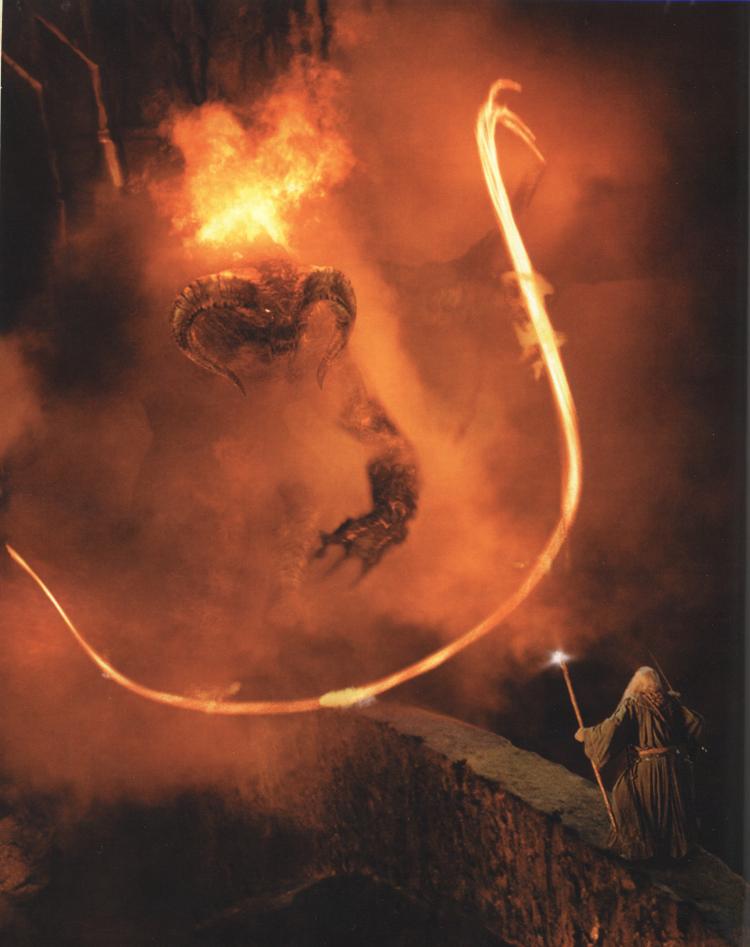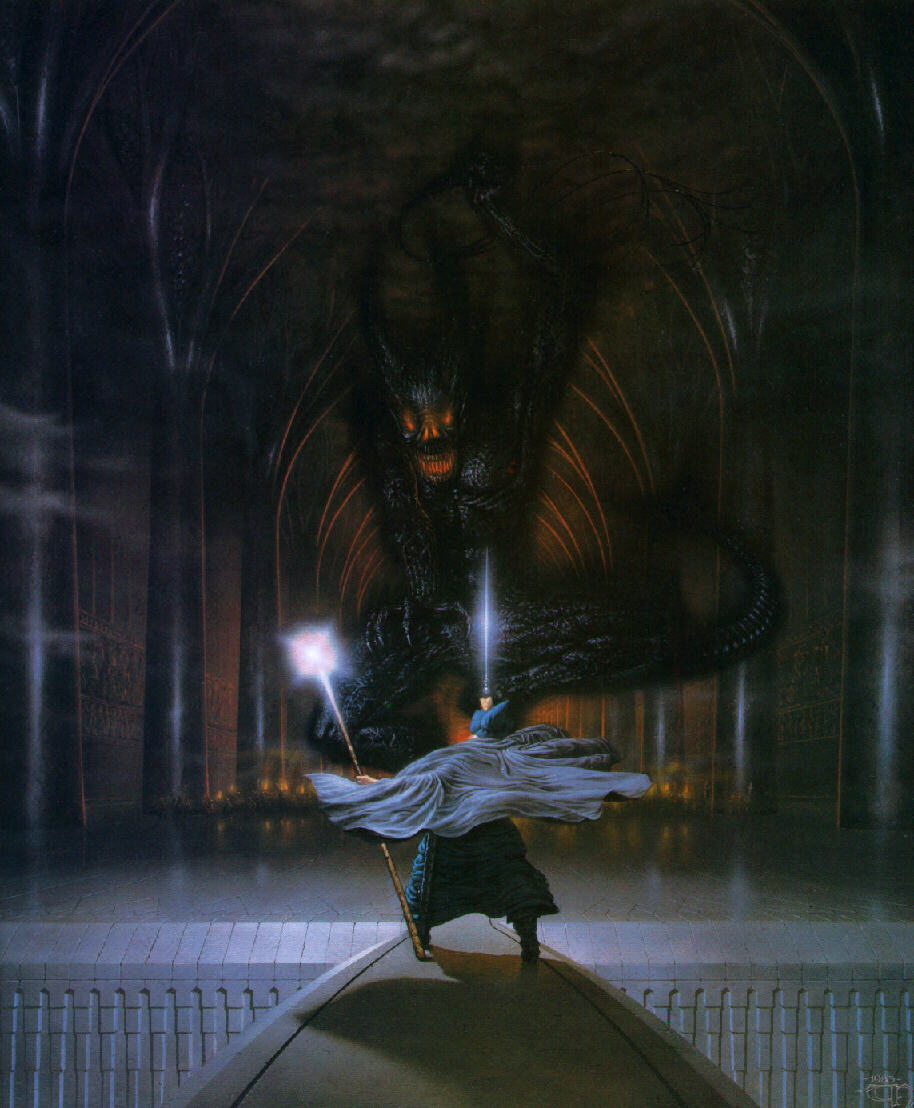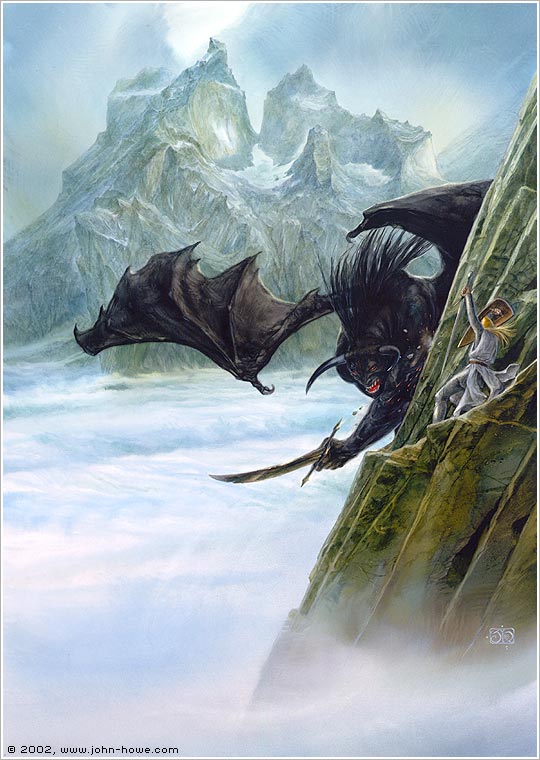 Anyway, according to The Encyclopedia of Arda, this single question receives more user input than any other of the literally hundreds of entries on their site -- to such an extent that they have devoted several pages to the discussion of whether a Balrog has wings, whether they can fly (assuming they have wings), whether they can change shape and size at will (in order to accommodate both sides of the argument), etc. The subject has inspired scholarly essays, full-length book chapters, and a general feeling of chaos and uncertainty among Tolkien enthusiasts. If we don't know whether a Balrog has wings, then gosh darn, is there anything we can really know for sure about Middle-earth?
Anyway, according to The Encyclopedia of Arda, this single question receives more user input than any other of the literally hundreds of entries on their site -- to such an extent that they have devoted several pages to the discussion of whether a Balrog has wings, whether they can fly (assuming they have wings), whether they can change shape and size at will (in order to accommodate both sides of the argument), etc. The subject has inspired scholarly essays, full-length book chapters, and a general feeling of chaos and uncertainty among Tolkien enthusiasts. If we don't know whether a Balrog has wings, then gosh darn, is there anything we can really know for sure about Middle-earth?To start -- most coherent essays on this issue that I've read conclude that, based on painstakingly nit-picky considerations of what constitutes a metaphor, Balrogs probably don't have wings in the same sense as, say, the Great Eagles (see: deus ex machina), or the Nazgûl's flying beasts. To the No-Wings camp, this seems to justify the belief that Balrogs are utterly bereft of any sort of scary adornments attached to their backs, doomed to wander the darkened halls of Moria or Who-Knows-Where wearing an immortal sadface for their inability to take to the skies. (No-Wings folks don't seem to raise any stink about visualizations of Balrogs with tails, despite the fact that Tolkien never used the word "tail" in reference to them.)
But just like the camp that says they do indeed have actual, honest-to-goodness wings, that interpretation takes a flying leap in reaching its conclusion. One thing is (almost) certain: Balrogs don't fly. At least, we should assume this is true considering they fall to their deaths often enough that, if they could fly, they'd also have to be abysmally stupid (pun absolutely intended). But it is still entirely plausible that they might have wings, if only of a shadowy, ethereal sort. Why? Because they're servants of Morgoth, and as such, there's one thing they enjoy doing above almost anything else -- looking scary.
Think about the most descriptive passages concerning what may or may not be wings on a Balrog:

'His enemy halted again, facing him, and the shadow about it reached out like two vast wings.'
and
'...suddenly it drew itself up to a great height, and its wings were spread from wall to wall...'
and
'...suddenly it drew itself up to a great height, and its wings were spread from wall to wall...'
The Fellowship of the Ring, II 5, "The Bridge of Khazad-dûm"
If Tolkien didn't want us to imagine the shadowy cloud of a Balrog as looking strikingly similar to wings, why would he use the word twice within a few paragraphs, and in the only real physical description of this creature? Shadowy and ethereal does not mean functional, but it does mean it'll be lookin mighty intimidating -- which, as I'm sure none will deny, is exactly what Tolkien's bad guys just loooove to do.
This argument has been made before -- i.e., "A Balrog can have wings if it wants to have wings, because it's a lesser god and they do what they want." Well... cosmetic, non-functional, scary-as-hell wings, definitely.
Further, let's think about Tolkien's use of his languages, as we always should. Their names in both Sindarin and Quenya mean "demon of power." How do most people in the western hemisphere imagine a demon? Granted, there are many, many possibilities -- even a cursory glance at Wikipedia's page on demons reveals "demonology" to be a massive and convoluted subject (almost certainly more so than Tolkienology). However, my guess would be that a majority of people would describe a large, man-like creature with beastly features, horns, and wings, à la Lucifer and many other Christian visualizations of fallen angels (which, by they way, is more or less what Balrogs are). Search Google Images and see what comes up.
 To my extensive (but necessarily incomplete) knowledge, Tolkien does not use the morpheme for "demon," in any of his languages, to collectively describe a class of creatures other than Balrogs. "Orc" can also mean "demon" in his Elvish tongues, but it also carries other connotations, and as far as I can tell, "rog" in "Balrog" and "rauko" in "Valarauko" are not etymologically related to it. ("The word [orc] is, as far as I am concerned, actually derived from Old English orc 'demon', but only because of its phonetic suitability" -- the author, The Letters of J. R. R. Tolkien) Regarding his use of the morphemes "rog" and "rauko," though, this might be an indication that "demon" meant something fairly specific to him, especially considering that, despite being a devout Catholic and acknowledging The Lord of the Rings as a "fundamentally religious" work, he almost always avoided using words or concepts with any strong Christian connotations. Once the reader becomes aware of the meaning of the creature's name, it seems nearly unavoidable that many should imagine it with wings, or at the very least, extremely wing-like forms expanding behind it.
To my extensive (but necessarily incomplete) knowledge, Tolkien does not use the morpheme for "demon," in any of his languages, to collectively describe a class of creatures other than Balrogs. "Orc" can also mean "demon" in his Elvish tongues, but it also carries other connotations, and as far as I can tell, "rog" in "Balrog" and "rauko" in "Valarauko" are not etymologically related to it. ("The word [orc] is, as far as I am concerned, actually derived from Old English orc 'demon', but only because of its phonetic suitability" -- the author, The Letters of J. R. R. Tolkien) Regarding his use of the morphemes "rog" and "rauko," though, this might be an indication that "demon" meant something fairly specific to him, especially considering that, despite being a devout Catholic and acknowledging The Lord of the Rings as a "fundamentally religious" work, he almost always avoided using words or concepts with any strong Christian connotations. Once the reader becomes aware of the meaning of the creature's name, it seems nearly unavoidable that many should imagine it with wings, or at the very least, extremely wing-like forms expanding behind it.
Fortunately for the casual fan, but unfortunately for us Wing-Agnostics, Tolkien was actively against forcing a single, particular meaning on the reader. His primary interest was to entertain with an enjoyable fantastical narrative, and he frequently indicated his displeasure with both over-analysis of a text to the point of meaninglessness ("He who breaks a thing to find out what it is has left the path of wisdom" -- Gandalf), and with the "tyranny" of authors who intentionally fashion a story so as to deny any freedom of interpretation. See The Letters of J. R. R. Tolkien for many examples of this sentiment, as well as the Foreword to The Lord of the Rings.
My final conclusion, then, is basically an altered version of an above statement: Balrogs (almost certainly) don't fly, but a Balrog can have wings if you want it to have wings, because Tolkien was an author who wanted you to enjoy the story to its fullest. My Balrogs have wings of shadow because I think they look more intimidating and evil that way, and that enhances my enjoyment of Tolkien's writing. Tolkien was vague about the appearance of Balrogs -- probably intentionally, what with the whole "cloaked in shadow" thing. It's a fact we should face with excitement rather than frustrated deliberation.
As of two days ago, I have a much more important question on my mind. Balrogs: hosts or a handful? The answer could change my visualization of an entire age of Middle-earth.

This argument has been made before -- i.e., "A Balrog can have wings if it wants to have wings, because it's a lesser god and they do what they want." Well... cosmetic, non-functional, scary-as-hell wings, definitely.
Further, let's think about Tolkien's use of his languages, as we always should. Their names in both Sindarin and Quenya mean "demon of power." How do most people in the western hemisphere imagine a demon? Granted, there are many, many possibilities -- even a cursory glance at Wikipedia's page on demons reveals "demonology" to be a massive and convoluted subject (almost certainly more so than Tolkienology). However, my guess would be that a majority of people would describe a large, man-like creature with beastly features, horns, and wings, à la Lucifer and many other Christian visualizations of fallen angels (which, by they way, is more or less what Balrogs are). Search Google Images and see what comes up.
 To my extensive (but necessarily incomplete) knowledge, Tolkien does not use the morpheme for "demon," in any of his languages, to collectively describe a class of creatures other than Balrogs. "Orc" can also mean "demon" in his Elvish tongues, but it also carries other connotations, and as far as I can tell, "rog" in "Balrog" and "rauko" in "Valarauko" are not etymologically related to it. ("The word [orc] is, as far as I am concerned, actually derived from Old English orc 'demon', but only because of its phonetic suitability" -- the author, The Letters of J. R. R. Tolkien) Regarding his use of the morphemes "rog" and "rauko," though, this might be an indication that "demon" meant something fairly specific to him, especially considering that, despite being a devout Catholic and acknowledging The Lord of the Rings as a "fundamentally religious" work, he almost always avoided using words or concepts with any strong Christian connotations. Once the reader becomes aware of the meaning of the creature's name, it seems nearly unavoidable that many should imagine it with wings, or at the very least, extremely wing-like forms expanding behind it.
To my extensive (but necessarily incomplete) knowledge, Tolkien does not use the morpheme for "demon," in any of his languages, to collectively describe a class of creatures other than Balrogs. "Orc" can also mean "demon" in his Elvish tongues, but it also carries other connotations, and as far as I can tell, "rog" in "Balrog" and "rauko" in "Valarauko" are not etymologically related to it. ("The word [orc] is, as far as I am concerned, actually derived from Old English orc 'demon', but only because of its phonetic suitability" -- the author, The Letters of J. R. R. Tolkien) Regarding his use of the morphemes "rog" and "rauko," though, this might be an indication that "demon" meant something fairly specific to him, especially considering that, despite being a devout Catholic and acknowledging The Lord of the Rings as a "fundamentally religious" work, he almost always avoided using words or concepts with any strong Christian connotations. Once the reader becomes aware of the meaning of the creature's name, it seems nearly unavoidable that many should imagine it with wings, or at the very least, extremely wing-like forms expanding behind it.Fortunately for the casual fan, but unfortunately for us Wing-Agnostics, Tolkien was actively against forcing a single, particular meaning on the reader. His primary interest was to entertain with an enjoyable fantastical narrative, and he frequently indicated his displeasure with both over-analysis of a text to the point of meaninglessness ("He who breaks a thing to find out what it is has left the path of wisdom" -- Gandalf), and with the "tyranny" of authors who intentionally fashion a story so as to deny any freedom of interpretation. See The Letters of J. R. R. Tolkien for many examples of this sentiment, as well as the Foreword to The Lord of the Rings.
My final conclusion, then, is basically an altered version of an above statement: Balrogs (almost certainly) don't fly, but a Balrog can have wings if you want it to have wings, because Tolkien was an author who wanted you to enjoy the story to its fullest. My Balrogs have wings of shadow because I think they look more intimidating and evil that way, and that enhances my enjoyment of Tolkien's writing. Tolkien was vague about the appearance of Balrogs -- probably intentionally, what with the whole "cloaked in shadow" thing. It's a fact we should face with excitement rather than frustrated deliberation.
As of two days ago, I have a much more important question on my mind. Balrogs: hosts or a handful? The answer could change my visualization of an entire age of Middle-earth.

I'm of the "hosts" camp. I don't have citations like you do, but I do know that Balrogs are former Maia, and Maia seemed to me to be the "population" of Heaven, the lesser angels, in The Silmarillion.
ReplyDeleteAgreed. I mean, let's be honest -- you can never really have too many Balrogs, can you?
ReplyDelete